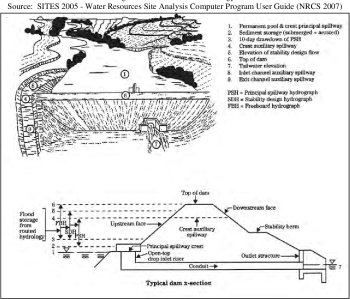Inflow Design Flood

|
| A diagram discussing inflow design flood analysis.
(Image Source: TR-210-60 Earth Dams and Reservoirs, NRCS, 2019) |
According to the Association of State Dam Safety Officials (ASDSO), the most common dam failure incident mechanism between 2010 and 2019 was dam overtopping.[1] The dam spillway, and its Inflow Design Flood (IDF), must have sufficient capacity and freeboard to prevent overtopping from occurring.
“Selection of an IDF can involve tradeoffs in trying to satisfy multiple objectives including: (1) providing acceptable safety to the public; (2) effectively applying the resources of the dam owner; (3) maintaining the credibility of the regulator in representing the interest of the public; (4) assessing the desire of the public for the benefits of a dam in exchange for the inherent risks that come from living downstream of a dam. No single approach to the selection of an IDF is adequate for the unique situations of thousands of existing or planned dams”.[2]
FEMA P-94 provides federal guidelines for selecting the Inflow Design Flood (IDF) of a given dam using one of four recommended approaches: a prescriptive standard, a site-specific Probable Maximum Precipitation (PMP) study, an incremental consequence analysis, or a Risk-Informed Decision Making (RIDM) analysis.
Prescriptive Standard Approach
The prescriptive standard approach, being the simplest, is based on a particular dam’s potential for causing loss of life and significant economic and environmental damage in the event of its failure. This potential for causing loss of life and other damages was defined by FEMA previously in the document Federal Guidelines for Dam Safety: Hazard Potential Classification System for Dams.[3] Dams can fall under one of three Hazard Potential Classifications: Low Hazard Potential, Significant Hazard Potential, and High Hazard Potential. Depending on the classification assigned to a particular dam, different requirements for the IDF are applied by FEMA P-94 as listed in Table 2 of the document.
Site-Specific PMP Study Approach
The site-specific PMP study approach relies on a more detailed, rigorous, and current hydrologic analysis that is more tailored to the conditions at the location of the particular dam rather than more generalized and commonly available PMP studies such as the Hydrometeorological Reports (HMR) published by the National Weather Service (NWS) for the region in which the dam is located. The extra effort required to conduct a more site- and project-specific study can reduce the uncertainty in the calculation of the resulting PMP estimate for the dam, potentially lowering the resulting magnitude of the IDF resulting in a smaller spillway and savings in construction costs.
Incremental Consequence Analysis Approach
The incremental consequence analysis approach considers the overall effect that a failure of the dam due to hydrologic deficiencies would have in the consequences downstream with that of the same dam that would not fail due to sufficient spillway capacity. Should the difference in the consequences of the two scenarios become negligible, it is determined that increasing the IDF of the spillway would not significantly increase the benefit to the public when compared to the necessary costs.
Risk-Informed Decision Making Approach
The RIDM analysis approach allows for dam owners to assess and compare all potential failure modes, as well as their estimated consequences, for the dam and assigning probabilities to each. This allows dam owners to compare the risks associated with every potential failure mode and informs their decisions on how to most efficiently allocate limited resources to most effectively reduce the risk of a failure of the dam.
Examples
Best Practices Resources
![]() Federal Guidelines for Dam Safety: Hazard Potential Classification System for Dams (FEMA P-333)
Federal Guidelines for Dam Safety: Hazard Potential Classification System for Dams (FEMA P-333)
![]() Selecting and Accommodating Inflow Design Floods for Dams (FEMA P-94)
Selecting and Accommodating Inflow Design Floods for Dams (FEMA P-94)
Trainings
![]()
Citations:
Revision ID: 7835
Revision Date: 03/28/2024
